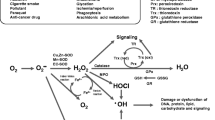Abstract
Advanced glycation end products (AGEs) have been identified in age-related intracellular protein deposits of Alzheimer’s disease (amyloid plaques and neurofibrillary tangles) and Parkinson disease (Lewy bodies), suggesting that these protein deposits have been exposed to AGE precursors such as the reactive dicarbonyl compound methylglyoxal. In ageing tissue and under diabetic pseudohypoxia, intracellular methylglyoxal levels rise through an impairment of triosephosphate utilization. Furthermore, methylglyoxal detoxification is impaired when reduced glutathione levels are low, conditions, which have all been described in Alzheimer’s disease. However, there is less known about the toxicity of methylglyoxal, particularly about therapeutic strategies to scavenge such dicarbonyl compounds and attenuate their toxicity. In our study, extracellularly applied methylglyoxal was shown to be toxic to human neuroblastoma cells in a dose-dependent manner above concentrations of 150 µM with a LD50 of approximately 1.25 mM. Pre-incubation of methylglyoxal with a variety of carbonyl scavengers such as aminoguanidine or tenilsetam and the thiol antioxidant lipoic acid significantly reduced its toxicity. In summary, carbonyl scavengers might offer a promising therapeutic strategy to reduce the neurotoxicity of reactive carbonyl compounds, providing a potential benefit for patients with age-related neurodegenerative diseases.
Similar content being viewed by others
References
Abordo EA, HS Minhas and PJ Thornalley (1999) Accumulation of alpha-oxoaldehydes during oxidative stress: a role in cytotoxicity.Biochem. Pharmacol. 58, 641–648.
Berridge MV and AS Tan (1993) Characterization of the cellular reduction of 3-(4,5-dimethylthiazol-2-yl)-2,5-diphenyltetrazolium bromide (MTT): subcellular localization, substrate dependence, and involvement of mitochondrial electron transport in MTT reduction.Arch. Biochem. Biophys. 303, 474–482.
Chaplen FW, WE Fahl and DC Cameron (1998) Evidence of high levels of methylglyoxal in cultured Chinese hamster ovary cells.Proc. Natl. Acad. Sci. USA 95, 5533–5538.
Chen F, MA Wollmer, F Hoerndli, G Munch, B Kuhla, EI Rogaev, M Tsolaki, A Papassotiropoulos and J Gotz (2004) Role for glyoxalase I in Alzheimer’s disease.Proc. Natl. Acad. Sci. USA 101, 7687–7692.
Dukic-Stefanovic S, R Schinzel, P Riederer and G Münch (2001) AGES in brain ageing: AGE-inhibitors as neuroprotective and anti-dementia drugs?Biogerontology 2, 19–34.
Gasic-Milenkovic J, C Loske, W Deuther-Conrad and G Münch (2001) Protein “AGEing”-cytotoxicity of a glycated protein increases with its degree of AGE-modification.Z. Gerontol. Geriatr. 34, 457–460.
Kajimoto Y, T Matsuoka, H Kaneto, H Watada, Y Fujitani, M Kishimoto, K Sakamoto, M Matsuhisa, R Kawamori, Y Yamasaki and M Hori (1999) Induction of glycation suppresses glucokinase gene expression in HIT-T15 cells.Diabetologia 42, 1417–1424.
Kikuchi S, K Shinpo, F Moriwaka, Z Makita, T Miyata and K Tashiro (1999) Neurotoxicity of methylglyoxal and 3-deoxyglucosone on cultured cortical neurons: synergism between glycation and oxidative stress, possibly involved in neurodegenerative diseases.J. Neurosci. Res. 57, 280–289.
Liu BF, S Miyata, Y Hirota, S Higo, H Miyazaki, M Fukunaga, Y Hamada, S Ueyama, O Muramoto, A Uriuhara and M Kasuga (2003) Methylglyoxal induces apoptosis through activation of p38 mitogen-activated protein kinase in rat mesangial cells.Kidney Int. 63, 947–957.
Loske C, A Neumann, AM Cunningham, K Nichol, R Schinzel, P Riederer and G Münch (1998) Cytotoxicity of advanced glycation endproducts is mediated by oxidative stress.J. Neural Transm. 105, 1005–1015.
Markesbery WR (1997) Oxidative stress hypothesis in Alzheimer’s disease.Free Radic. Biol. Med. 23, 134–147.
Montine TJ, MD Neely, JF Quinn, MF Beal, WR Markesbery, LJ Roberts and JD Morrow (2002) Lipid peroxidation in aging brain and Alzheimer’s disease.Free Radic. Biol. Med. 33, 620–626.
Münch G, Y Taneli, E Schraven, U Schindler, R Schinzel, D Palm and P Riederer (1994) The cognition-enhancing drug tenilsetam is an inhibitor of protein crosslinking by advanced glycosylation.J. Neural Transm. Park. Dis. Dement. Sect. 8, 193–208.
Münch G, J Thome, P Foley, R Schinzel and P Riederer (1997) Advanced glycation endproducts in ageing and Alzheimer’s disease.Brain Res. Brain Res. Rev. 23, 134–143.
Münch G, AM Cunningham, P Riederer and E Braak (1998) Advanced glycation endproducts are associated with Hirano bodies in Alzheimer’s disease.Brain Res. 796, 307–310.
Münch G, HJ Lüth, A Wong, T Arendt, E Hirsch, R Ravid and P Riederer (2000) Crosslinking of alpha-synuclein by advanced glycation endproducts - an early pathophysiological step in Lewy body formation?J. Chem. Neuroanat. 20, 253–257.
Shinpo K, S Kikuchi, H Sasaki, A Ogata, F Moriwaka and K Tashiro (2000) Selective vulnerability of spinal motor neurons to reactive dicarbonyl compounds, intermediate products of glycation,in vitro: implication of inefficient glutathione system in spinal motor neurons.Brain Res. 861, 151–159.
Shoda H, S Miyata, BF Liu, H Yamada, T Ohara, K Suzuki, M Oimomi and M Kasuga (1997) Inhibitory effects of tenilsetam on the Maillard reaction.Endocrinology 138, 1886–1892.
Suzuki K, YH Koh, H Mizuno, R Hamaoka and N Taniguchi (1998) Overexpression of aldehyde reductase protects PC 12 cells from the cytotoxicity of methylglyoxal or 3-deoxyglucosone.J. Biochem. (Tokyo) 123, 353–357.
Thornalley PJ (1990) The glyoxalase system: new developments towards functional characterization of a metabolic pathway fundamental to biological life.Biochem. J. 269, 1–11.
Thornalley PJ (1993) The glyoxalase system in health and disease.Mol. Aspects Med. 14, 287–371.
Thornalley PJ, A Langborg and HS Minhas (1999) Formation of glyoxal, methylglyoxal and 3-deoxyglucosone in the glycation of proteins by glucose.Biochem. J. 344 Pt. 1, 109–116.
Thornalley PJ, A Yurek-George and OK Argirov (2000) Kinetics and mechanism of the reaction of aminoguanidine with the alpha-oxoaldehydes glyoxal, methylglyoxal, and 3-deoxyglucosone under physiological conditions.Biochem. Pharmacol. 60, 55–65.
Author information
Authors and Affiliations
Corresponding author
Rights and permissions
About this article
Cite this article
Webster, J., Urban, C., Berbaum, K. et al. The carbonyl scavengers aminoguanidine and tenilsetam protect against the neurotoxic effects of methylglyoxal. neurotox res 7, 95–101 (2005). https://doi.org/10.1007/BF03033780
Received:
Revised:
Issue Date:
DOI: https://doi.org/10.1007/BF03033780




